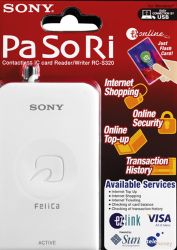EZ-Link to debut online top-up service

update SINGAPORE--Local payment service provider EZ-Link will introduce a new online service that allows users to top up contactless payment cards using a computer.
Dubbed EZ Online, the new service requires Sony's Pasori card reader to be attached to any Internet-enabled PC in order to add cash value into the ez-link contactless cards. In addition, users can also view card transactions and download electronic shopping coupons into the cards.
The ez-link card is Singapore's contactless payment card that is widely used to pay for bus and train rides. It is also accepted as a payment mode at some convenience stores and fast food outlets. The ez-link card is similar to the Octopus card in Hong Kong, the Oyster card in the United Kingdom and the Suica in Japan.
To date, more than 9 million ez-link cards have been issued in Singapore.
According to Nicholas Lee, senior vice president of EZ-Link, EZ Online is the first of its kind outside Japan.
Previously, ez-link cardholders can only add cash value into their cards at kiosks located at train stations and selected retail merchants across the island-state.
With the new service, cardholders can now pay for their online cash top-ups using Visa credit and debit cards. There are plans to include other credit cards in future, Lee added.
Apart from adding cash value from a PC terminal, EZ Online also allows cardholders to perform remote top-ups, according to Lee. This means parents can now increase the cash values of their children's ez-link cards by entering each card's unique identification number. When the cards are tapped at ez-link card readers at transit points and retail outlets, cash values can be credited immediately.
For a limited period, EZ-Link is waiving the transaction fee for ez-link top-ups using the EZ Online service. In future, users will be required to pay S$0.30 (US$0.19)--similar to the fee that is currently charged at retail merchants that provide similar top-up services, Lee said.
 Sony Pasori card reader |
Like the Octopus card in Hong Kong, there are plans to extend the use of ez-link cards further into the retail space, Lee noted.
According to Chua Siew Ling, general manager of QB, non-transportation transactions currently make up a "very low" proportion of total ez-link card transactions in Singapore. QB is a local company that helps to promote and extend the use of the payment card, for example, by establishing new retail and other business partnerships.
Priced at S$49 (US$31), the Sony Pasori card reader--together with the EZ Online service--will be commercially available on Sept. 9.
Playing catch-up?
While EZ Link is working to expand Singapore's use of ez-link cards beyond transportation, Hong Kong's Octopus card is already recognized as one of the world's most successful contactless payment cards.
According to Octopus Cards CEO Eric Tai, there are 13.5 million Octopus cards in circulation and 75 million transactions worth HK$7.5 million are registered per day. More than 20 percent of total transactions are not related to transportation.
"We have good shareholders who helped us get a good foot into the business when we [first] started," Tai told ZDNet Asia. He added that the Octopus card has seen significant success expanding into the retail space.
"We have a very strong team who worked in the marketplace to acquire merchants and get our customers to use our product," he said. "We've also got a very receptive customer base and supportive merchants who are willing to work with us to make things happen."
So far, some 370 merchants in Hong Kong accept the Octopus card as a payment mode. Singapore's EZ-Link, however, is mainly accepted at schools, hospitals and just over 10 merchants including McDonald's fast food outlets, supermarket chain NTUC Fairprice and 7-Eleven convenience stores.
Most contactless payment cards in the world have unique identification numbers and personalized features, allowing for authentication and access control functions to be deployed. For instance, the Octopus card is currently used to gain physical access into nearly 200 commercial buildings and residential estates in Hong Kong.
According to the company, Octopus cardholders only need to register their cards with the office building management and their card numbers can be stored in the buildings' central security systems. Authorized cardholders simply wave their Octopus cards over the reader at the door to enter the buildings.
QB's Chua said plans are in the pipeline to add access control functions to the ez-link card, as well as provide merchants with insight into their customers' spending habits. "We can provide information to the merchants, such as the kinds of things their customers buy and what hours of the day they buy," she said.
In view of privacy concerns, such information will only be collected based on consumer groups, and not on an individual level, she added.
Tai said Octopus already provides customer relationship management information to its merchants, while adhering to the Privacy Ordinance in Hong Kong.
"Retailers always understand their customers' consumption patterns, they just don't know who is consuming what," he explained. "We work with retailers to provide stratified and non-customer specific information, so that they know how different customer segments are performing."